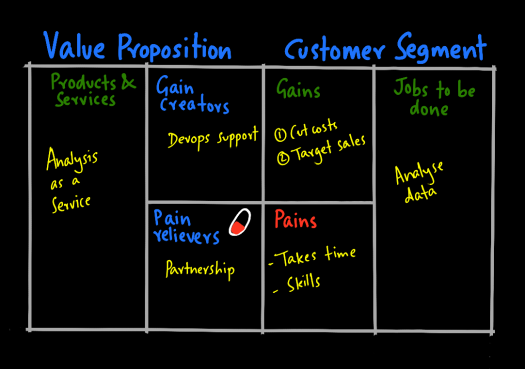
The acid test of a product is whether people will buy it.
It makes sense to have a systematic approach to testing our assumptions about how customers will respond, and a new canvas from the folks that developed the Business Model Canvas called the Value Proposition Canvas.
There are a couple of versions of this floating around, but the type in the picture above is easy to draw and work with.
The Value Proposition canvas has two main sections - what we do and think it does for customers, and our assumptions about the jobs our customers need doing and what that means for them.
Starting from the customer end, if they get their jobs done, we assume that they get certain gains.
These might simply be lower costs or greater sales.
Or they might be operational - better quality, intangible - greater corporate social responsibility scores or brand recognition.
If that is the case, they why aren't they doing more about it already?
It's usually because there are things in the way - pains that stop them from moving forward.
This then leads to a simple matching exercise that we need to do.
When we look at the products and services that we offer, which ones are gain creators and which ones are pain relievers?
If we can match gain creators to the gains that customers want and pain relievers to the pains that they have, then we have a better chance of creating value that a customer will be willing to pay for.
Let's take an example of a company that does data analysis for customers - providing an Analysis as a Service proposition.
Many companies collect large amounts of data - from sales and product information to energy usage and cost data.
We might assume that if they could use this data more effectively, targeting areas where there are hidden costs or by using it to better target their sales efforts, then they could reduce costs or increase sales.
The problem is that there is more data than can be analysed using tools such as Excel, it takes time and many organisations can't spare the skilled people that it needs to do this.
So, the service provider might see an opportunity to provide trained staff on a consulting basis, perhaps Devops engineers who can do both development and operations and work closely with managers and existing technical people to extend and develop the tools needed to do this.
If the area we are working in is core to the business, then it could be run as a partnership between the service provider and the company.
If it's non-core, it could be outsourced.
A simple canvas such as this quickly makes the assumptions we have about the product and customer visible.
The next step is to get out of the building, as Steve Blank says, and talk to potential customers and test our assumptions.
We refine our model based on the conversations we have and iterate until we have something that is market ready.
And that has a better chance of passing our acid test.